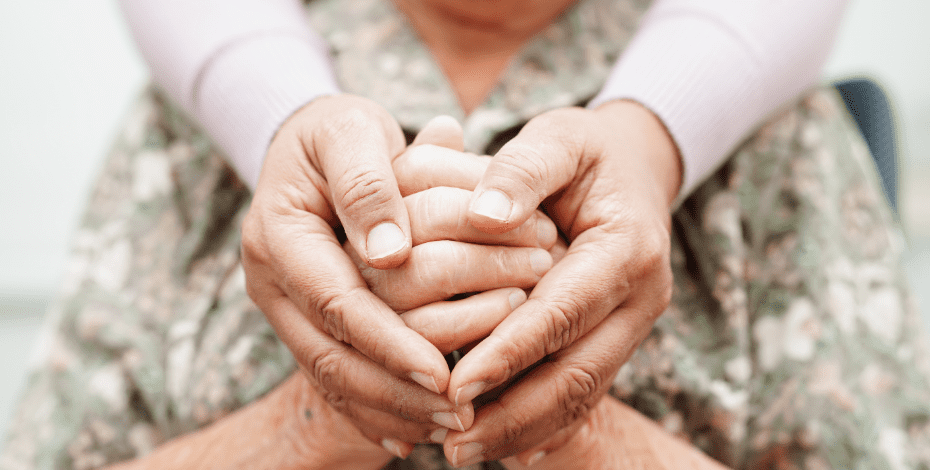
Five facts about palliative care in aged care

Dharani Nagarajan, Ciara Wright, James Chirgwin, Stacey Papa, Sally Mathieson and Craig Hagan present five discussion points about the role of palliative care physiotherapy in aged care.
1. Palliative care focuses on symptom management

Palliative care can be defined as ‘an approach that improves the quality of life of patients (adults and children) and their families who are facing problems associated with life-threatening illness.
It prevents and relieves suffering through the early identification, correct assessment and treatment of pain and other problems, whether physical, psychosocial or spiritual’ (World Health Organization 2020).
Misconceptions and a lack of awareness among policymakers, health professionals and the public about what palliative care can become a barrier to appropriate care.
It is important to understand that end-of-life care is only one part of palliative care.
A person can receive palliative care at any age, as an adjunct to ongoing treatment and according to need rather than prognosis.
As the population ages, a rising incidence of life-limiting chronic illnesses means that a growing number of older adults receiving care will also require some form of palliative care—not necessarily traditional end-of-life care, but care based on the fact that their symptoms require ongoing effective management (Centre for Health Economics Research and Evaluation 2018).
Palliative care is patient-centred, with identified goals that are realistic, driven by the patient’s priorities and focused on quality of life (Galekop et al 2019).
2. A multidisciplinary approach is central to palliative care

Palliative care addresses multiple needs and concerns of the patient.
These may include physical, psychological, social and spiritual needs, which cannot be addressed by one single person or specialty (Mitra & Vadivelu 2013).
Considering the complexity of care required to meet the needs of a person with an incurable condition, a multidisciplinary team is essential for balancing curative and palliative interventions (Vissers et al 2012).
A multidisciplinary care team allows for shared decision-making, responsibility and leadership.
Medical practitioners, nurses, psychologists, social workers, chaplains, pharmacists, physiotherapists, occupational therapists, speech pathologists and other allied health professionals each contribute their specific expertise while working together in a cohesive way.
Different members will be required at different times and some may be needed more often than others (Hui et al 2018).
‘I know services are working well when I don’t have to repeat my story 20 times’—Jane, aged 45, living with motor neurone disease (Victorian Government 2016).
This is what cohesive, coordinated care means.
With all team members working together, holistic and timely care can augment the support provided by family and other caregivers to achieve optimal palliative care (Hui et al 2018).
3. Physiotherapists provide palliative care in a variety of settings

Australian residential aged care facilities provide long-term accommodation for those who cannot remain safely at home and respite accommodation when carers and family need a break from their normal living arrangements.
Physiotherapists support people in residential aged care facilities, who often have complex needs, addressing common concerns such as mobility impairments, pain and incontinence (Brett & Ilhan 2022).
In a hospital setting, physiotherapy improves and stabilises patient function and slows down functional deterioration through active, specialised modalities and dynamic assessments designed to maximise outcomes.
This improves independence, bringing physical and psychological relief in many aspects of life.
Physiotherapy also provides the necessary education and tools for families or caregivers to manage and improve conditions throughout the progress of the disease (Navarro-Meléndez et al 2023).
Physiotherapists play many other roles in hospital-based palliative care, including end-of-life support care, discharge planning and translating jargon and complexities so that they make sense to everyone involved.
Community physiotherapy is carried out in many settings, including during home visits and in community and group classes.
In all these modalities, the goal is to improve physical function and independence, focusing on mobility, bed mobility, transferring, standing balance, gentle exercise, education and socialisation (Carson & McIlfatrick 2013).
4. Palliative care physiotherapy focuses on improving quality of life

Physiotherapy in palliative care has a positive impact on quality of life by reducing fatigue and increasing physical activity and functionality levels (Pyszora et al 2017).
Symptom management also encompasses pain, motor deficits, constipation, breathlessness, lymphoedema and depression (Pyszora et al 2017).
Interventions in palliative care include exercise prescription, massage and myofascial release, respiratory physiotherapy and advice on positioning, mobility aids, equipment prescription and manual handling (Bernabeu-Wittel et al 2021).
Addressing symptoms through physiotherapy can lead to improved quality of life and decreased caregiver strain (Pyszora et al 2017, Bernabeu-Wittel et al 2021).
As the patient progresses through the palliative phases and their condition changes, physiotherapy interventions will need ongoing adaptation (CareSearch 2018).
An advanced care plan is a document outlining a patient’s preferences for treatment and intervention based on their individual values and goals for care (Agarwal & Epstein 2018, Dinescu 2021).
An effective advanced care plan will utilise the skills of each member of the multidisciplinary team and symptom management is often included (Myers et al 2018).
It has been demonstrated that quality of life improves when an advanced care plan accurately defines a patient’s end-of-life preferences (Silvester et al 2013).
5. Physical activity can be beneficial in palliative care

Physical activity can be safe and beneficial for patients receiving palliative care (Eyigor 2014).
It plays a role in maintaining function, managing symptoms and helping people achieve their quality of life goals (Toohey et al 2023).
For people with palliative care needs, physiotherapy is guided by their symptoms and their sense of what is important to them (CareSearch 2018).
Because the progression of life-limiting conditions is variable and palliative care focuses on symptom management, not just end-of-life care, people may receive palliative care for a number of years and their activity levels and goals can be expected to change over the different phases of care (Palliative Care Australia 2018).
Exercise and physical activity can be conducted one on one with a therapist, can be self-led or can be part of a group setting, allowing increased peer support (Malcolm et al 2016).
Physiotherapy can take place in an acute setting, as part of rehabilitation or in the home environment (Palliative Care Australia 2018).
Precautions may need to be taken to manage risk factors such as heart failure (Queensland Health 2019), blood count abnormalities (Morishita et al 2020) or bone metastases (Campbell et al 2022).
A skilled physiotherapist working within the multidisciplinary team can assist with balancing physical activity and avoiding complications from these risk factors.
Quick links:
- References
- Infographic poster of this article.
Course of interest:
Palliative rehabilitation: contradiction or best practice?
>> Dharani Nagarajan APAM is the physiotherapy manager at Access Health and Community in Melbourne; has worked across the public, private and community sectors for over 22 years; and is the chair of the Victorian branch of the APA Cancer, Palliative Care and Lymphoedema group.
>> Ciara Wright APAM is a physiotherapist and team leader at BlueCross Community and Residential Services in Melbourne, has experience in both public and private sectors in Australia and the UK, and is secretary of the Victorian branch of the APA Gerontology group.
>> James Chirgwin APAM is the senior oncology and palliative care physiotherapist at the Wesley Hospital in Brisbane; has worked across public and private hospitals in Queensland, Tasmania and the UK; and is a committee member of the Queensland branch of the APA Cancer, Palliative Care and Lymphoedema group.
>> Stacey Papa APAM is a senior physiotherapist at Hellenic Community Aged Care in Perth and the vice chair of the Western Australian branch of the APA Gerontology group.
>> Sally Mathieson APAM is the senior neurological physiotherapist at Access Health and Community, has over five years’ experience in progressive neurology and palliative care at Calvary Health Care Bethlehem and is a committee member of the Victorian branch of the APA Cancer, Palliative Care and Lymphoedema group.
>> Craig Hagan has a background in exercise physiology and rehabilitation stemming from his professional sporting experience. Craig is in his final year of a physiotherapy master’s degree and works as a physiotherapy assistant in Sydney across aged care, private practice and sports.
© Copyright 2024 by Australian Physiotherapy Association. All rights reserved.





